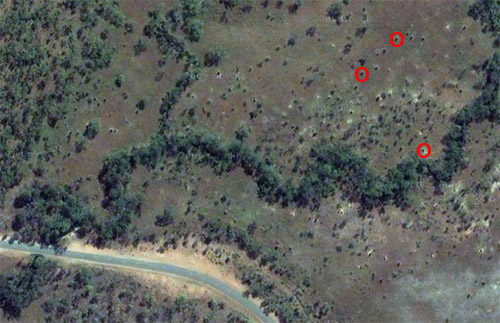
Termite mounds visible in Australia's Northern Territory- I've circled three, but dozens are in the image.
Central Illinois still resembles the frozen lifeless tundra, so to get my bug-hunting fix I've been surfing about on Google Earth. Here at -13.066783, 130.847383 I've found something: Australia's magnificent magnetic termites. The green things are trees, but the little black pimply bits? Those are the termites. On the ground they look like this:
Why "magnetic"?
The mounds are shaped as thin blades along a north-south orientation as though following compass direction. The reasons for this odd architecture are still a matter of research, but the general view is that the shape helps termites avoid the heat of the tropical midday sun, and the extra surface area allows for more efficient respiration.



neat!
In December my wife and I took the train from Alice Springs to Darwin, and the number, size, and clustering of termite mounds was amazing-- literally dozens of different sizes, quite close together. A regular Manhattan of termites...
HI Alex
In NW Missouri, around 40 28' 26''N 94 04'35''W, there are zillions of Formica montana mounds visible, especially after fires, as in your photos.
I can't get a decent image on Google Earth, but maybe that's because I have the fuzzy free version. Or, maybe it's because they don't have the nice clearing around them that the termite, Pogo and Atta nests mounds have.
I think the problem is the images for that location are too low resolution. I had a look around similar habitats that google has in higher res, and may have found some mounds here:
41° 2'21.23"N 96°33'24.47"W
What do you think?
Those could be ant mounds. I wouldn't want to venture a species ID, though. How'd you happen to look at that particular location hidden in all that ag land in Nebraska? Perhaps you've been there and saw ant mounds?
I took a look at the FermiLab site (Batavia IL), another site with numerous F. montana mounds. Grayish-looking spots on the clearer parts of the image seem to me almost certainly big ant mounds. Mounds on never-plowed areas inside the accelerator ring are the source population for these ants in the restored areas, and the gray spots there are the largest and most readily visible. Look especially where Inner Ring Road tees.
I was surprised that this DOE research lab had higher resolution images than some site in rural NW MO, but I guess I don't understand the logic of Google Earth.